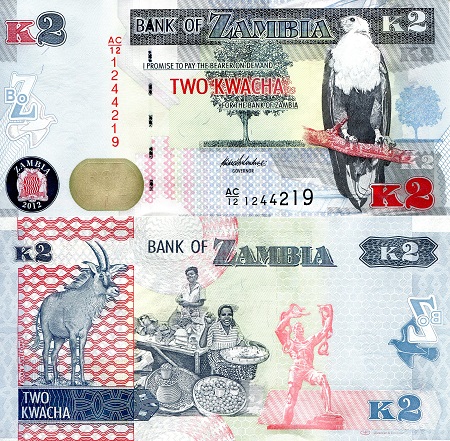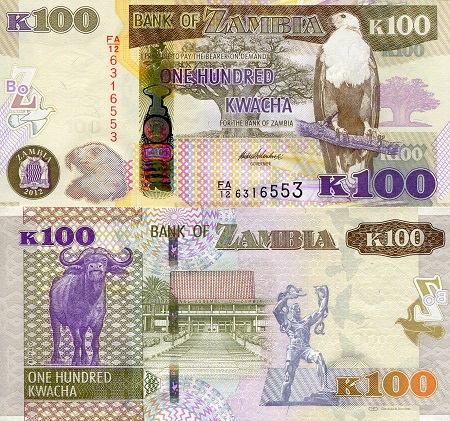One of my favorite series of notes when I started collecting was the Zambia notes, from the beautiful animals pictured to the consistency of their design, I have a special fondness for these extraordinary notes – which could explain my excitement when I received the new banknotes issued from 2012 (for 2013), and now I get to share them with you all.
As I mentioned, one thing I love about these notes are the great animals pictured on them, like some of their prior notes, all the new ones also feature an animal that represents their country on the back left hand side of the note:
- 2 Kwacha– the roan antelope
- 5 Kwacha– the magnificent mighty lion
- 10 Kwacha– presents a prickly porcupine
- 20 Kwacha– the black lechwe
- 50 Kwacha– a prowling leopard
- lastly the 100 Kwacha– showcases the beautiful buffalo. (these notes are available for purchase at robertsworldmoney.com)
The second thing I love about Zambia’s notes is the consistency in their design, honoring their history and their country:
1. The first thing I notice when I look at these notes is the beautiful bird, the Fish Eagle. This bird has been featured on every note since 1992. The Fish Eagle replaced a portrait of Kenneth Kaunda, the first president of Zambia who served from 1964-1991, who had been featured on their earlier currency. (However some notes included both the president and the Fish Eagle but after 1991 Kaunda was removed from the notes and the Bird was highlighted). The Fish Eagle is a large species of eagles that are found throughout sub-Saharan Africa wherever large bodies of water can be found, and is the national bird of Zambia (as well as
Zimbabwe!) “The fish eagle is said to reflect Zambians’ pride; the excellent vision and swift reaction symbolizes the country’s focus on economic growth and its ability to rise above the country’s challenges. The calmly seated eagle on a branch of a tree represents stability in prices,” (Quote from the central bank of Zambia)
2. Secondly- I notice the trees in the background of the note, each of six different notes depict six different trees from Zambia. Older notes also feature the fantastic foliage from their region, but I love how each different note depicts a different tree.
3. If you look at the back of each note you’ll see the famous “chain-breaker” statue. This symbol of freedom was added after 1989 to all banknotes.
In 2003 Zambia became the first African country to issue polymer banknotes, however this new series is not printed on polymer. This new currency became legal tender on January 1st 2013, and will circulate for six months with the old currency allowing residences time to switch over. After July 1st 2013 the old currency will not be accepted for ordinary transactions, however, banks will continue to exchange the old notes for new ones at no fee until June 3rd 2014.
The New notes are an attempt to return Zambia’s currency to a more manageable level, the the old unit value will be divided by a thousand; K5,000 becomes K5 and K50,000 becomes K50, etc. Most of the existing notes will have equivalents in the new currency, but two new notes are being introduced. The new K100 note will be equivalent to the current K100,000 and K2 will be equivalent to the current K2,000. These will be the highest and lowest value bank notes.
I am so excited to have these notes to share with other collectors and enthusiasts- don’t forget I have older series available as well as this new set.
View All Zambia Notes
Thanks for reading-hope you have a chance to see these amazing notes for yourself.



